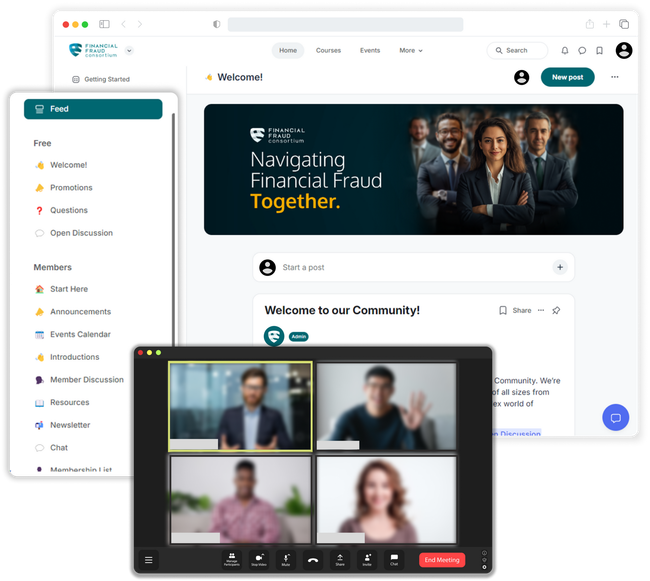Get in touch
+44 1632 96099
mymail@mailservice.com
Navigating Financial Fraud Together.

Collaborate with other financial institutions in identifying, detecting, and implementing best practices to combat the complex world of financial fraud.







Why Membership Matters
No matter the size, all financial institutions understand that the evolving payments ecosystem is always at ever-increasing risk. As fraud increases in frequency and sophistication, collaboration plays a vital part in preventing, detecting, and responding to events to mitigate considerable financial losses or significant risk to reputation in the marketplace.
Collaboration stands as the backbone of our community. Your financial institution's membership provides opportunities to build your network, share resources, and mobilize your expertise to proactively detect, expose and mitigate fraud within all facets of the rapidly evolving payments industry.

Realtime
Collaboration
Flexible Accessibility
Exclusive Resources
Webinars & Thinktanks
Post and chat with other member institutions to navigate questions & scenarios.
Learn and engage with our membership on your own schedule with 24/7 access.
Access our library of member written and other exclusive industry resources.
Attend monthly membership meetings featuring exclusive speakers from anywhere.
Memberships Include
Membership has been invaluable to our organization by providing a unique platform that fosters collaboration among industry leaders, regulatory bodies, and financial institutions. The insights, resources, and best practices we gain from being part of this network are critical in helping us stay ahead of evolving fraud threats.
Jim Goodin
CCO, USA Digital Communiications

The FFC has been a game-changer for me and my team. The networking opportunities have been instrumental in learning form others' experiences and the monthly knowledge sharing sessions have provided us with fresh insights and ideas to enhance our fraud prevention measures. I highly recommend it to anyone looking to stay ahead of curve in the fight against financial fraud!
Andrea Valentin
SVP Fraud & Risk, Old Glory Bank

Being a part of the FFC from the start has been an incredibly enriching experience for ENACOMM. The opportunity to collaborate with industry leaders and exchange knowledge on fraud prevention strategies has had a profound impact on our business. We actively apply what we learn to help our clients anticipate fraud trends, implement safeguards, and optimize costs. I highly recommend joining this dynamic and forward-thinking organization.
Bill Lee
Customer Success Manager, ENACOMM

Collaborate. Educate. Mitigate.
Who We Are
As financial institutions, we are united by a common concern:
We recognize that fraud results in considerable financial losses and poses a significant reputational risk. Ongoing expenses for preventing, detecting, and responding to fraud further increases direct costs.
Fundamentally, we have joined forces to discuss ways we can increase the efficiency of transaction processing and enable effective countermeasures while balancing the customer experience.
We are all stronger when we work together.
Our Leadership Team

President
Andrea Valentin
Old Glory Bank
Andrea has more than twenty-five years’ experience in banking and the financial services industry. She previously served as VP, Prepaid Operations division of US Bank, where she was responsible for the Prepaid Financial Intelligence Unit (FIU), bank relations/program management, Reg E dispute processing, complaint response teams and KYC/CIP, AML, and fraud prevention. Andrea is a founding member and President of the Financial Fraud Consortium (FFC), she served on the ACFE Scholarship foundation as its chair, is a board member for the Meadowlark Art Council, and she serves as an advisory board member to the Northeast Florida Chapter of the Association of Certified Financial Crime Specialists (ACFCS). Andrea has a BA in accounting from the University of Central Florida and an MBA in Economic Crime and Fraud Management from Utica College. Andrea’s case, Small Town Boys, appears in Joseph Wells’ “Internet Fraud Casebook: The World Wide Web of Deceit”.

Vice-President
Lisa-Marie Braun
Mastercard
As VP of Products in the North America Cyber & Intelligence Solutions team at Mastercard, Lisa-Marie Braun is focused on innovation, artificial intelligence, and enabling brand agnostic fraud mitigation capabilities.
Lisa brings a unique perspective having over 14 years of experience in investigations, fraud mitigation rule writing, and product management.

Secretary
Jim Goodin
USA Digital Communications
Jim Goodin is the Chief Commercial Officer at USA Digital Communications, where he leads strategic initiatives aimed at driving growth, fostering innovation, and enhancing commercial operations. With over two decades of experience in the technology and communications sectors, Jim has developed a strong reputation for crafting effective business strategies, identifying new market opportunities, and building lasting industry partnerships that support the long-term success of the organization. USA Digital Communications provides connectivity and voice solutions and has built a unique set of fraud services to meet our customer needs.

Director at Large
Bill Lee
ENACOMM
Bill is the Customer Success Manager for ENACOMM, a provider of innovative, interactive and intelligent customer self-service applications to financial industry customers ranging from Prepaid/Debit/Payments to traditional Community Financial Institutions.
Bill brings over thirty years of experience in Information Technology.

Member at Large
Amanda Johnson
US Bank
Amanda Johnson is a Certified Fraud Examiner (CFE) and Certified Fraud Crime Specialist (CFCS) with 14 years of experience in the financial service industry. She has a BA in Supervision and Management with a concentration in Accounting from Daytona State College and an MBA in Forensic Accounting from New England College. She is currently an Operations Manager for Prepaid Vendor Management at US Bank. She currently manages vendors that support Gateway Services, Cardholder Communications, and Disputes platform applications. She has a background in Fraud Operations where she managed fraud prevention and detection programs, neural network rules and cases, country blocking, and monitoring of the Automatic Number Identification (ANI) fraud module databases.

Member at Large
Cynthia Wallace
DCI
Cynthia has over 30 years in the payments industry including check, call centers, bank sponsorship, FinTech, prepaid and gift, crypto, and digital payments; and describes herself as a recovering Chief Compliance Officer of FinTech. Cynthia’s extensive experience in the payments industry, ranging from Fortune 500 banks to FinTech start-ups and payment processing, provides her with a diverse skillset that allows her to lead and exceptional fraud and compliance department as the Fraud Investigations Manager at DCI. Her professional qualifications include certifications as an Anti-Money Laundering Specialist from ACAMS (Association of Certified Anti-Money Laundering Specialists) and as a Fraud Examiner recognized by the ACFE (Association of Certified Fraud Examiners). These certifications indicate her expertise and commitment to combatting financial crimes and ensuring compliance with payments regulations.

President Emeritus
Grant Rogers
Advantage Payment Solutions
With over 25 years of experience in the payments arena, Grant Rogers has been a part of the growth and maturity of the prepaid and fintech business since its’ earliest stages. At First Data, Grant worked with prepaid and gift card partners who pioneered a new payments ecosystem and quickly recognized the potential of this new vertical market.
As Executive Vice-President and General Manager of Advantage Payment Services, Grant is responsible for the overall management, development and delivery of services. APS has enjoyed strong success under Grant’s leadership and has attracted strategic partnerships with MetaBank, Bancorp and others. The APS team prides itself on honesty, integrity and fairness.
Our Mission
To mobilize the consortiums’ expertise to proactively detect, expose and mitigate fraud within all facets of the rapidly evolving payments industry
Membership Levels
Silver
Qualifications
- < $1B Asset Size (Bank or publicly traded organization)
- 1 – 50 Employees (Privately held company)
Delegates
- 1 Primary Delegate
- No Additional Delegates
Purchase Membership
One-Year Committment
$1,500
Two Year Commitment
$2,225
per 1 year agreement
per 2 year agreement
Gold
Qualifications
- $1 - 9.9B Asset Size (Bank or publicly traded organization)
- 51 - 99 Employees (Privately held company)
Delegates
- 1 Primary Delegate
- 1 - 2 Additional Delegates
Purchase Membership
One-Year Committment
$2,500
Two Year Commitment
$4,500
per 1 year agreement
per 2 year agreement
Platinum
Qualifications
- $10B+ Asset Size (Bank or publicly traded organization)
- 100+ Employees (Privately held company)
Delegates
- 1 Primary Delegate
- 1 - 4 Additional Delegates
Purchase Membership
One-Year Committment
$5,000
Two Year Commitment
$10,000
per 1 year agreement
per 2 year agreement
Recent Posts



Contact Us
Thank you for contacting us!
We will get back to you as soon as possible.
Please try again later.



